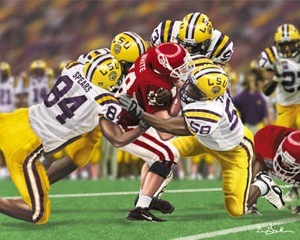Fall of Empire?




Despite the reforms of Diocletian and Constantine, the revival did not hold up. after Constantine the decline set in again, and this time it got worse and worse.
A few events will give you an idea of the time frame and the causes. About 350 AD the Germans began to move into the Empire in serious numbers, and now they were coming in not as settlers but as warriors. In 378 AD a tribe called the Visigoths destroyed a Roman army and killed the Emperor Valens at a battle called Adrianople and from then on the Romans just could not keep the Germans at bay.
In 410 a German general who was actually serving in the Roman army turned on Rome itself and sacked the city. This was the first time that Rome had been conquered in ten centuries. Finally, in 476 AD a German chief named Odoacer conquered Rome and expelled the Emperor Romulus Augustulus (a boy), and that is considered by historians the fall of the Roman Empire. It was even considered at the time the fall of the Roman Empire. However, I want you to put in your notes that 476 AD is the fall of the Roman Empire in the West. Not in the East. In the East it continues for another 1000 years.
“Fall” might be a bit too harsh a term for what happened to the Roman Empire. The Empire did not actually fall, even in the West, so much as fade away under the tensions of invasion and change, yet, much that was Roman remained!
First, I’ll mention the Byzantine, or Eastern Roman Empire, founded by Constantine when he moved the capital of the Empire from Rome to Constantinople. Historians call it the Byzantine Empire, but the people who lived there never called it anything but the Roman Empire. This empire continued to exist, and to preserve both Roman and Hellenistic Greek traditions until 1453. The language of the Empire was Greek, but the legal language was Latin, and Byzantine Emperors preserved the Roman civil law. In fact in the mid-500s the Emperor Justinian had the Roman Law codified more completely than any other Romans ever had, and most of what we know about Roman law (which is a lot) we owe to Justinian. Justinian also closed down all of the pagan schools of philosophy because they competed with Christianity, but he and other emperors collected and stored pagan literature (both Greek and Latin) for posterity. So, long after the fall of Rome, there were still people who considered themselves Roman, and some ways still acted Roman, in the East.


Justinian (above) ruled a Roman Empire in the East that would last until 1453.
In the West after 476, increasingly different German tribes carved little kingdoms out for themselves. But the populations that they controlled were Romans, so German kings did all they could to be Roman as well. They converted to Christianity, the employed Roman civil servants and advisors, they maintained as best they could Roman institutions like assemblies and gladiatorial contests — they did all that they could to maintain a certain degree of romanitas in their kingdoms. Perhaps the greatest of these Roman kings came long after the fall of Rome. He was a Frank named Charles, who travelled to the city of Rome in 800 A.D. and had himself crowned Roman Emperor of the West by the Pope. To Charlemagne, and most Medieval kings, the Roman Emperors had the kind of power that they could only dream of, and dream they did.
In the Western Europe of the Middle Ages most people longed for the order and security of the Roman Empire, and the two major innovations in Government and economics reflect that a great deal. The economic institution called manorialism that preserved some degree of prosperity and economic security in Western Europe grew out of the great manor systems of the late empire that grew out of Diocletian’s requirement that farmers stay on the land.
The political system that dominated the Middle Ages in one form or another was called feudalism. Its roots may be found both in the German idea of the comitatus and in the Roman patron/client system of patrocinium.
Finally, the Christian Church also preserved much that was Roman. The language of the Church in the West was Latin, so the educated language of the West remained Latin up to the 17th century. Many of the positions of the Church, much of the style of the Church rites, were borrowed from Roman pagan religion. For instance, one of the titles of the Pope is Pontifex Maximus (great bridge builder), the title of the supreme priest in pagan Rome.
So, much that was Roman, and, indeed much that was classical survived the fall of the city of Rome itself, and in one form or another passed from the Classical Age, through the Middle Ages, and even down to us today. If you doubt that, take a look at the architecture of the older buildings on the L.S.U. campus, compare the Louisiana Civil Code to the Codes of Justinian, and perhaps, go watch Gladiator, than attend a college football game.



